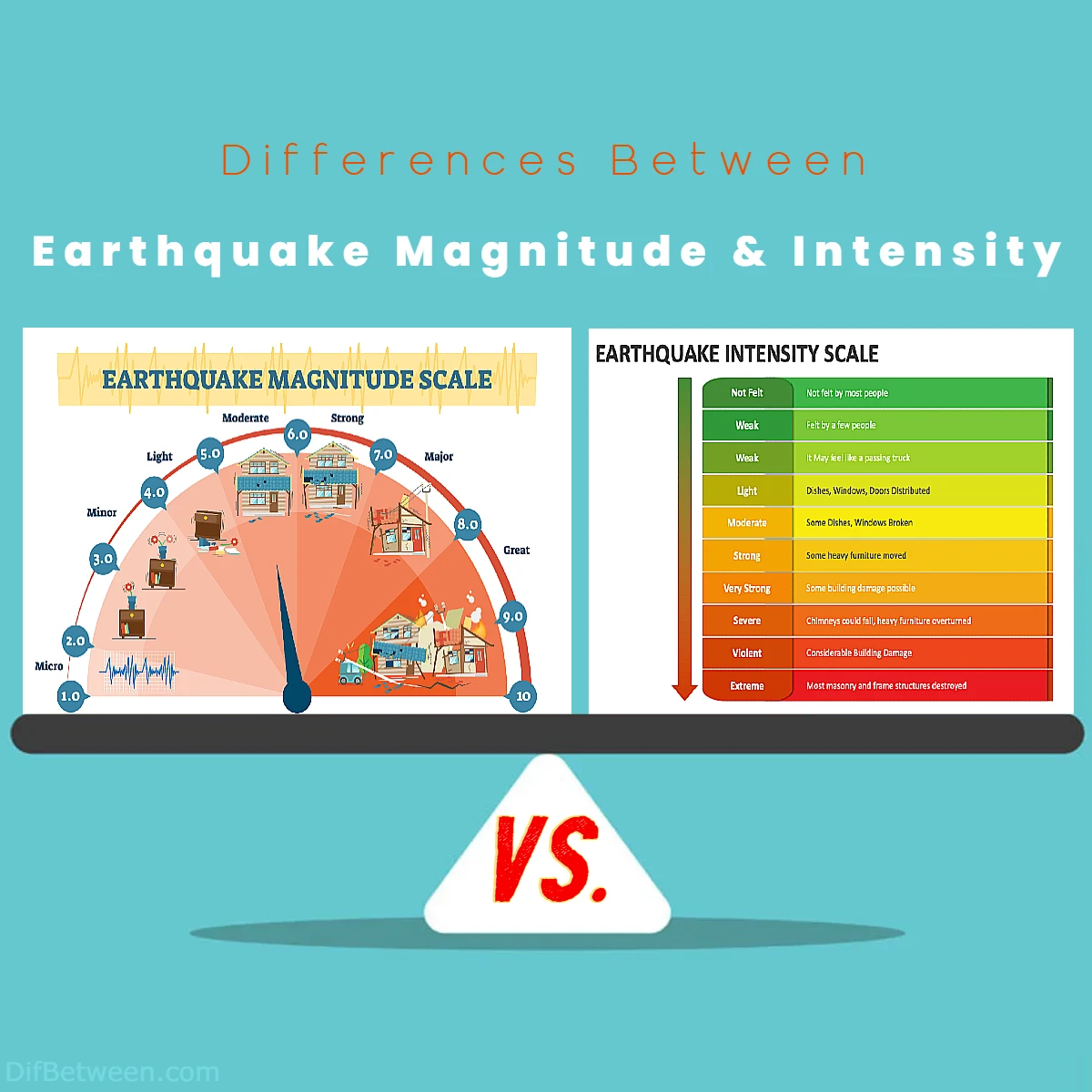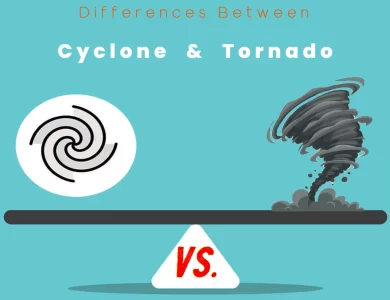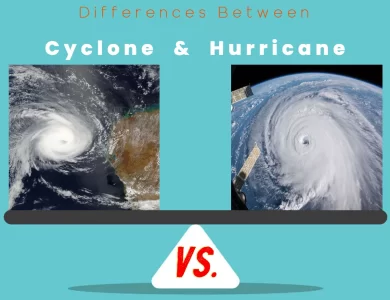
| Aspect | Earthquake Magnitude | Earthquake Intensity |
|---|---|---|
| Definition | Measures the energy released at the earthquake’s source. | Describes the observed effects and impacts of an earthquake at specific locations. |
| Measurement Method | Relies on seismographs and analyzes seismic waves. | Assessed through field surveys, observations, and reports. |
| Standard Scales | Richter scale, moment magnitude scale (Mw). | Modified Mercalli Intensity (MMI) scale. |
| Measurement Units | Dimensionless number (e.g., 7.0). | Roman numerals (I to XII). |
| Focus | Physical property of the earthquake itself. | Human-centric, focusing on the impact on people, buildings, and the environment. |
| Geographic Variation | Consistent, regardless of the location of measurement. | Varies geographically; different areas affected by the same earthquake can experience different intensity levels. |
| Real-Life Examples | Highlighted in news reports and seismic monitoring systems (e.g., 9.0 magnitude Tōhoku earthquake). | Evident through descriptions of its impact in affected areas (e.g., Tōhoku earthquake’s varying intensity levels across Japan). |
| Use in Engineering and Construction | Used to design earthquake-resistant structures. | Vital for assessing the vulnerability of existing buildings and guiding retrofitting efforts. |
| Emergency Response and Public Awareness | Contributes to early warning systems. | Critical for post-event emergency response and public awareness campaigns. |
| Magnitude and Frequency | Associated with the potential for significant ground shaking. Large-magnitude earthquakes are less frequent. | Can vary even for earthquakes of the same magnitude, influenced by local geology and distance from the epicenter. |
| Scientific and Educational Value | Fundamental parameter in seismology and earthquake research. | Provides valuable data for historical earthquake studies and public education. |
| Global vs. Local Perspective | Offers a global perspective on seismic hazard assessment. | Provides a localized perspective, emphasizing community-level preparedness. |
When it comes to earthquakes, we often encounter two terms: magnitude and intensity. At first glance, they may seem like interchangeable jargon, but oh, they are not! These two concepts hold the keys to deciphering the true nature of seismic occurrences. What’s the difference between the energy unleashed at an earthquake’s epicenter and the impact it has on our world’s surface? How can understanding these distinctions help engineers design safer structures, aid emergency responders in times of crisis, and empower us, the public, with knowledge to navigate seismic zones?
Differences Between Earthquake Magnitude and Intensity
The main differences between Earthquake Magnitude and Intensity lie in their fundamental nature and measurement. Earthquake Magnitude quantifies the energy released at the earthquake’s source, utilizing scales like the Richter scale or moment magnitude (Mw), providing a single numerical value for size and power. In contrast, Earthquake Intensity focuses on the effects of the earthquake at specific locations, described on the Modified Mercalli Intensity (MMI) scale using Roman numerals. These distinctions are crucial: Magnitude helps assess seismic hazard on a broader scale and informs engineering practices, while Intensity guides immediate emergency response and offers a localized perspective on an earthquake’s impact.
1. Definition and Focus
- Magnitude: Earthquake magnitude is a measure of the energy released at the earthquake’s source. It provides a single numerical value to characterize an earthquake’s size and power.
- Intensity: Earthquake intensity focuses on the effects of the earthquake on the Earth’s surface at specific locations. It provides a qualitative description of the shaking and damage experienced in various areas.
2. Measurement Scales
- Magnitude: Magnitude is typically measured on logarithmic scales such as the Richter scale or moment magnitude scale (Mw). These scales assign a single number to represent the earthquake’s size.
- Intensity: Intensity is measured on the Modified Mercalli Intensity (MMI) scale, which uses Roman numerals from I to XII to describe the earthquake’s effects. Each numeral corresponds to a specific level of intensity.
3. Quantitative vs. Qualitative
- Magnitude: Magnitude provides a quantitative measure of an earthquake’s size and energy release. It is expressed as a single numerical value.
- Intensity: Intensity is qualitative and describes the observed effects and impacts of an earthquake at specific locations. It uses Roman numerals to convey different levels of shaking and damage.
4. Uniformity Across Locations
- Magnitude: The magnitude of an earthquake is the same regardless of where it is measured. A magnitude 7.0 earthquake will have the same magnitude value no matter where you are.
- Intensity: Earthquake intensity can vary significantly from one location to another, even for the same earthquake. Different areas may experience different intensities based on their proximity to the epicenter and local geological conditions.
5. Scientific vs. Practical Use
- Magnitude: Earthquake magnitude is primarily used by scientists and engineers for seismic research, hazard assessment, and earthquake-resistant building design.
- Intensity: Earthquake intensity is more practical for emergency response, public awareness, and assessing the impact on communities and infrastructure.
6. Continuous vs. Discrete Data
- Magnitude: Magnitude provides continuous data, allowing for fine-grained distinctions between earthquakes of different sizes.
- Intensity: Intensity data is discrete, with specific categories or levels that describe the observed effects.
7. Predictive vs. Post-event
- Magnitude: Magnitude can be determined shortly after an earthquake occurs, providing valuable information for early warning systems.
- Intensity: Intensity is assessed after the earthquake has occurred, based on field surveys and reports from affected areas.
8. Units of Measurement
- Magnitude: Magnitude is expressed as a dimensionless number. For example, a magnitude 6.0 earthquake has no units.
- Intensity: Intensity is described using Roman numerals (I to XII) on the MMI scale, with each numeral representing a different level of intensity.
9. Role in Seismic Hazard Assessment
- Magnitude: Magnitude is a crucial parameter for assessing seismic hazard at a regional or global scale. It helps scientists estimate the likelihood of large earthquakes occurring in specific areas.
- Intensity: Earthquake intensity is more relevant for local hazard assessment and emergency response planning. It helps communities prepare for and respond to earthquakes based on observed impacts.
10. Measurement Methods
- Magnitude: The measurement of earthquake magnitude relies on seismographs and the analysis of seismic waves. Scientists calculate magnitude by comparing the amplitude and frequency of these waves. Moment magnitude (Mw) is the modern standard for measuring magnitude, offering a more accurate representation of large earthquakes than the original Richter scale.
- Intensity: Measuring earthquake intensity involves subjective observations and field surveys. Scientists and trained personnel assess the effects on structures, landscapes, and human experiences. The Modified Mercalli Intensity (MMI) scale provides a standardized way to describe these observed effects.
11. Physical vs. Human-Centric
- Magnitude: Earthquake magnitude is a physical property of the earthquake itself, independent of human experiences or infrastructure. It quantifies the earthquake’s intrinsic power.
- Intensity: Earthquake intensity is human-centric, focusing on the impact of the earthquake on people, buildings, and the environment. It provides a human perspective on the event.
12. Geographic Variation
- Magnitude: Magnitude is consistent regardless of where it’s measured. A magnitude 6.0 earthquake in one location will have the same magnitude value as a 6.0 earthquake in a different location.
- Intensity: Earthquake intensity varies geographically. Different areas affected by the same earthquake can experience different intensity levels due to factors like distance from the epicenter and local geological conditions.
13. Real-Life Examples
- Magnitude: The magnitude of an earthquake is often highlighted in news reports and seismic monitoring systems. For example, the devastating 9.0 magnitude earthquake that struck Japan in 2011, known as the Tōhoku earthquake, was widely reported based on its magnitude.
- Intensity: Earthquake intensity becomes evident through descriptions of its impact. For instance, the Tōhoku earthquake, despite its high magnitude, resulted in varying levels of intensity across Japan, with some areas experiencing extreme shaking and damage while others felt weaker effects.
14. Use in Engineering and Construction
- Magnitude: Engineers and architects use earthquake magnitude data to design structures capable of withstanding the ground motion generated by earthquakes of specific magnitudes. This helps ensure the safety and resilience of buildings and infrastructure.
- Intensity: Intensity information is vital for assessing the vulnerability of existing buildings and infrastructure in an affected area. It guides retrofitting and reconstruction efforts to improve earthquake resilience.
15. Emergency Response and Public Awareness
- Magnitude: Earthquake magnitude contributes to early warning systems that can provide a few seconds to minutes of advance notice before shaking reaches a specific location. This allows for automated actions like stopping trains or alerting emergency services.
- Intensity: Earthquake intensity is crucial for post-event emergency response. It helps prioritize rescue and relief efforts by identifying areas with the greatest need for assistance. Public awareness campaigns also use intensity levels to convey the earthquake’s impact in relatable terms.
16. Magnitude and Frequency
- Magnitude: Magnitude is often associated with the potential for significant ground shaking and widespread damage. Large-magnitude earthquakes (e.g., 7.0 or higher) are less frequent but have the potential for catastrophic impact.
- Intensity: Earthquake intensity can vary even for earthquakes of the same magnitude. Factors like local geology and distance from the epicenter play a significant role in determining the intensity experienced at a specific location.
17. Scientific and Educational Value
- Magnitude: Earthquake magnitude is a fundamental parameter in seismology and earthquake research. It contributes to our understanding of plate tectonics, fault dynamics, and the Earth’s internal processes.
- Intensity: Earthquake intensity provides valuable data for historical earthquake studies and helps educate the public about the real-world consequences of seismic events.
18. Global vs. Local Perspective
- Magnitude: Magnitude offers a global perspective on earthquake energy release and seismic hazard assessment. It helps identify regions prone to large earthquakes based on geological features.
- Intensity: Earthquake intensity provides a localized perspective, emphasizing the need for preparedness and resilience at the community level. It aids in understanding how specific areas are affected during an earthquake.
Conclusion
In the world of seismic science and earthquake preparedness, understanding the differences between earthquake magnitude and intensity is paramount. These two measures, while related to the same geological event, serve distinct purposes. Magnitude quantifies the earthquake’s intrinsic power, providing a global perspective on seismic hazard. In contrast, intensity focuses on the human experience, describing the impact of an earthquake on communities, buildings, and the environment.
Both magnitude and intensity are essential tools for scientists, engineers, emergency responders, and the general public. They contribute to our ability to predict, prepare for, and respond to earthquakes, ultimately enhancing our resilience in the face of one of nature’s most formidable forces. As we continue to advance our understanding of earthquakes, the synergy between magnitude and intensity remains at the heart of earthquake research and risk reduction efforts worldwide.
FAQs
The primary difference is in what they measure. Earthquake magnitude quantifies the energy released at the earthquake’s source, providing a single numerical value for the earthquake’s size and power. Earthquake intensity, on the other hand, describes the observed effects and impacts of an earthquake at specific locations, using the Modified Mercalli Intensity (MMI) scale with Roman numerals.
Earthquake magnitude is typically measured using seismographs and scales like the Richter scale or moment magnitude (Mw) scale. In contrast, earthquake intensity is assessed through field surveys, observations, and reports from affected areas, and it’s expressed on the MMI scale.
Earthquake magnitude is crucial for assessing the potential for ground shaking and structural damage on a broader scale, aiding in seismic hazard assessment and engineering practices. Earthquake intensity is vital for immediate post-event emergency response, helping prioritize rescue efforts and guiding public awareness campaigns.
Yes, earthquake intensity can vary significantly from one location to another, even for the same earthquake. Factors such as distance from the epicenter, local geological conditions, and building construction quality influence intensity. Earthquake magnitude, however, remains consistent for the same earthquake regardless of where it’s measured.
Earthquake magnitude informs long-term seismic risk assessment and guides the design of earthquake-resistant structures. Earthquake intensity aids in immediate emergency response efforts, helping responders prioritize resources and assess damage, ultimately enhancing community preparedness and resilience.
Yes, the Richter scale and moment magnitude (Mw) scale are commonly used for measuring earthquake magnitude. Earthquake intensity is measured on the Modified Mercalli Intensity (MMI) scale, which uses Roman numerals to describe observed effects.
Earthquake intensity is more relevant for public awareness during an earthquake as it describes the actual impact on people, buildings, and the environment. It conveys the severity of the shaking and damage in relatable terms, helping the public understand the immediate effects of the earthquake.
Read More:
Contents
- Differences Between Earthquake Magnitude and Intensity
- 1. Definition and Focus
- 2. Measurement Scales
- 3. Quantitative vs. Qualitative
- 4. Uniformity Across Locations
- 5. Scientific vs. Practical Use
- 6. Continuous vs. Discrete Data
- 7. Predictive vs. Post-event
- 8. Units of Measurement
- 9. Role in Seismic Hazard Assessment
- 10. Measurement Methods
- 11. Physical vs. Human-Centric
- 12. Geographic Variation
- 13. Real-Life Examples
- 14. Use in Engineering and Construction
- 15. Emergency Response and Public Awareness
- 16. Magnitude and Frequency
- 17. Scientific and Educational Value
- 18. Global vs. Local Perspective
- Conclusion
- FAQs





